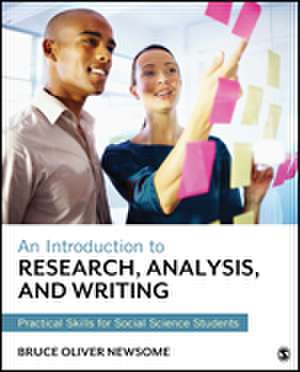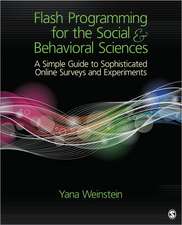An Introduction to Research, Analysis, and Writing: Practical Skills for Social Science Students
Autor Bruce Oliver Newsomeen Limba Engleză Paperback – 7 iul 2015
Preț: 519.30 lei
Preț vechi: 701.76 lei
-26% Nou
Puncte Express: 779
Preț estimativ în valută:
99.37€ • 104.03$ • 82.22£
99.37€ • 104.03$ • 82.22£
Carte disponibilă
Livrare economică 17-31 martie
Livrare express 01-07 martie pentru 34.35 lei
Preluare comenzi: 021 569.72.76
Specificații
ISBN-13: 9781483352558
ISBN-10: 1483352552
Pagini: 376
Dimensiuni: 187 x 232 x 19 mm
Greutate: 0.63 kg
Ediția:1
Editura: SAGE Publications
Colecția Sage Publications, Inc
Locul publicării:Thousand Oaks, United States
ISBN-10: 1483352552
Pagini: 376
Dimensiuni: 187 x 232 x 19 mm
Greutate: 0.63 kg
Ediția:1
Editura: SAGE Publications
Colecția Sage Publications, Inc
Locul publicării:Thousand Oaks, United States
Cuprins
1. The Way Ahead
Learning Objectives and Outcomes
Goals of This Book
Preview of the Rest of the Book
Chapter Summary
2. Research Process
Learning Objectives and Outcomes
Opening Vignette
What is Research?
What are the Objectives and Products of Research?
What are the Approaches to Research?
Project Life Cycle
Chapter Summary
Questions and Exercises
3. Research Ethics and Laws
Learning Objectives and Outcomes
Opening Vignette
What are Ethics?
Chapter Summary
Questions and Exercises
4. Scoping, Justifying, Designing, Planning
Learning Objectives and Outcomes
Opening Vignette
Scoping
The Value of Your Research
Feasibility
Developing a Research Question
Describing, Justifying, Planning, and Proposing the Research
Chapter Summary
Questions and Exercises
5. Reading and Reviewing
Learning Objectives and Outcomes
Opening Vignette
Sources
How to Read Efficiently
Content Analysis
Reviews
Chapter Summary
Questions and Exercises
6. Analysis
Learning Objectives and Outcomes
Opening Vignette
What is Analysis?
Why Do We Analyze?
How are We Told to Analyze?
How Should We Analyze?
Chapter Summary
Questions and Exercises
7. Arguing and Explaining
Learning Objectives and Outcomes
Opening Vignette
Definitions
Logical Arguments
True Arguments
Strong Versus Weak Arguments
Fallacious Arguments
Biases
Dialectic Arguments
Describing and Critiquing Arguments
Chapter Summary
Questions and Exercises
8. Theorizing and Modeling
Learning Objectives and Outcomes
Opening Vignette
Theories
Hypotheses
Models
Chapter Summary
Questions and Exercises
9. Methods
Learning Objectives and Outcomes
Opening Vignette
Methods and Methodologies
Historical Research
Case Study
Survey Research
Direct Observation in the Field
Experimental Research
Chapter Summary
Questions and Exercises
10. Evidence and Data
Learning Objectives and Outcomes
Opening Vignette
Observations and Data
Operationalization
Measurement
Classifying Data
Datasets
Uses of Data
Evidence
Causality and Correlation
Chapter Summary
Questions and Exercises
11. Writing
Learning Objectives and Outcomes
Opening Vignette
Planning the Writing of Your Whole Product
Style
Structure
Chapter Summary
Questions and Exercises
Learning Objectives and Outcomes
Goals of This Book
Preview of the Rest of the Book
Chapter Summary
2. Research Process
Learning Objectives and Outcomes
Opening Vignette
What is Research?
What are the Objectives and Products of Research?
What are the Approaches to Research?
Project Life Cycle
Chapter Summary
Questions and Exercises
3. Research Ethics and Laws
Learning Objectives and Outcomes
Opening Vignette
What are Ethics?
Chapter Summary
Questions and Exercises
4. Scoping, Justifying, Designing, Planning
Learning Objectives and Outcomes
Opening Vignette
Scoping
The Value of Your Research
Feasibility
Developing a Research Question
Describing, Justifying, Planning, and Proposing the Research
Chapter Summary
Questions and Exercises
5. Reading and Reviewing
Learning Objectives and Outcomes
Opening Vignette
Sources
How to Read Efficiently
Content Analysis
Reviews
Chapter Summary
Questions and Exercises
6. Analysis
Learning Objectives and Outcomes
Opening Vignette
What is Analysis?
Why Do We Analyze?
How are We Told to Analyze?
How Should We Analyze?
Chapter Summary
Questions and Exercises
7. Arguing and Explaining
Learning Objectives and Outcomes
Opening Vignette
Definitions
Logical Arguments
True Arguments
Strong Versus Weak Arguments
Fallacious Arguments
Biases
Dialectic Arguments
Describing and Critiquing Arguments
Chapter Summary
Questions and Exercises
8. Theorizing and Modeling
Learning Objectives and Outcomes
Opening Vignette
Theories
Hypotheses
Models
Chapter Summary
Questions and Exercises
9. Methods
Learning Objectives and Outcomes
Opening Vignette
Methods and Methodologies
Historical Research
Case Study
Survey Research
Direct Observation in the Field
Experimental Research
Chapter Summary
Questions and Exercises
10. Evidence and Data
Learning Objectives and Outcomes
Opening Vignette
Observations and Data
Operationalization
Measurement
Classifying Data
Datasets
Uses of Data
Evidence
Causality and Correlation
Chapter Summary
Questions and Exercises
11. Writing
Learning Objectives and Outcomes
Opening Vignette
Planning the Writing of Your Whole Product
Style
Structure
Chapter Summary
Questions and Exercises
Notă biografică
Descriere
Covering the full spectrum of skills needed, including planning, scoping, analysis, argumentation, theory building, modelling theories, methods, gathering data, presenting evidence, and writing, this book clearly helps students through each stage of doing a research project.





